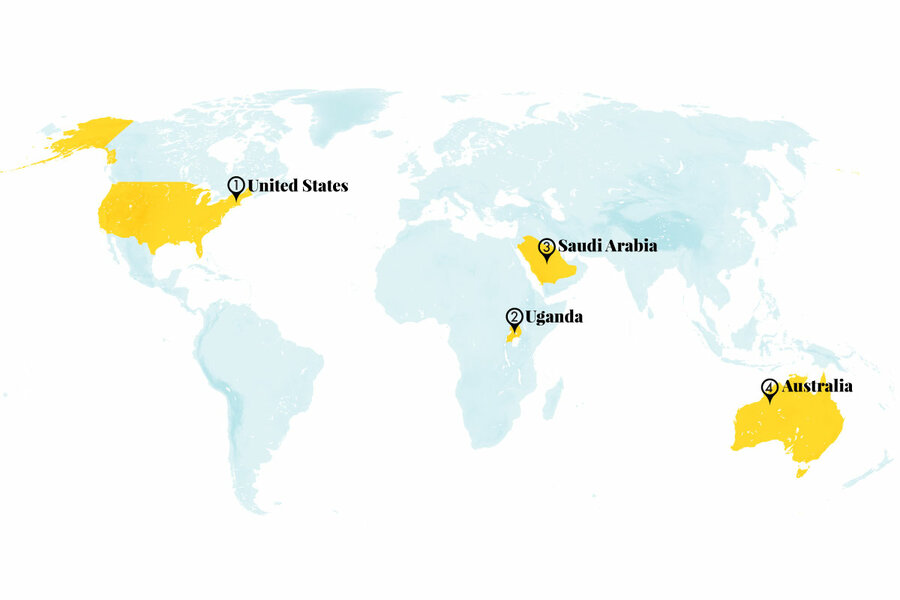Fairy circles and electricity from air: Inclusive and innovative science
Loading...
1. United States
Scientists are closer to extracting electricity from air. Expanding previous research on humidity and energy, engineers found that nanopores are key to pulling electricity from atmospheric moisture. As water molecules pass through a harvesting material with tiny holes, the charge imbalance between both sides of the material is similar to what is found in a cloud, and what enables the production of electricity.
In 2020, University of Massachusetts Amherst scientists published research describing what they call the “air-gen effect,” with a specific protein as the electricity harvester. But the new discovery expands potential harvesters to many other materials that can be engineered with holes less than 100 nanometers in diameter, less than a thousandth of the width of a human hair. Thin layers of harvesting material could be stacked to make electricity from ever-present humidity even at low levels, indoors or out.
Why We Wrote This
A story focused onOur progress roundup includes a science story from Australia, where elders co-authored research that incorporated their Indigenous expertise. And in news that would make Ben Franklin take notice, engineers discovered a secret to harvesting energy from humid air: very, very tiny holes.
“We are opening up a wide door for harvesting clean electricity from thin air,” said Xiaomeng Liu, the paper’s lead author.
Source: University of Massachusetts Amherst
2. Uganda
Communal farms in Uganda are proving effective in combating hunger. “Epicenters” provide pathways to economic and environmental sustainability by bringing together clusters of villages to share improved farming practices and services, which generally include a bank, a nursery school, toilets, clean water, and a medical clinic.
The Hunger Project nonprofit has established 12 food epicenters across Uganda, providing startup resources and training to each for up to five years, with the expectation that epicenters will become self-sufficient. Ten of those now operate without external support, and hunger rates have fallen in all but one of those that were measured. Each epicenter serves up to 15,000 people.
In addition to food security, the model focuses on female empowerment. Faridah Nakayiza has learned seed management and how to increase crop production. Before, she says, she often struggled to feed her family. Now she grows bananas, cassavas, pumpkins, and more. “We have excess,” she says, and “this shows women like me can provide.”
Source: Reasons to be Cheerful
3. Saudi Arabia
The International Space Station welcomed Saudi Arabia’s first female astronaut. Rayyanah Barnawi spent eight days in space, where the biomedical researcher and her Saudi colleague, Ali al-Qarni, performed cell experiments in microgravity on the first Saudi space trip in 40 years.
Saudi Arabia’s revived interest in space exploration is part of the kingdom’s Vision 2030, a reform program aimed at reducing oil dependence and creating jobs for young Saudis. The International Space Station represents a successful collaboration across nations, especially between Russia and the West.
Ms. Barnawi and Mr. Qarni joined two Americans, commander Peggy Whitson and pilot John Shoffner, on the mission operated by Axiom Space, a private company which intends to build the world’s first commercial space station.
In goodbyes to the International Space Station and its crew, Ms. Barnawi said the trip “is only the beginning of a new era for our country and our region.”
Sources: The National, SpaceNews, Al Jazeera
4. Australia
Indigenous knowledge is unlocking the mystery of Australia’s “fairy circles.” In a scientific paper, a cross-cultural team shared authorship with First Peoples. Scientists concluded that termites are a key player in forming the bare circular patches on the arid land of Western Australia.
Since the phenomenon was described 50 years ago as a feature of the Namib Desert in Africa, scientists have debated various causes of the patches. In previous studies in Australia, a dominant theory said that plants naturally organized themselves in a circle around a bare area in competition for water. A paper published in October concluded after three years of observations that plant water stress causes the fairy circles in Namibia, but that study did not include Australian sites.
While the Australian researchers incorporated Aboriginal art and narratives into their study, excavation of 60 trenches in northwestern Australia found evidence of termites in all of the spaces. “Aboriginal people have refined their encyclopaedic knowledge while living continuously on this continent for thousands of generations,” wrote the research team in The Conversation. “Listening to Aboriginal desert voices improved our understanding of how ubiquitous, but often overlooked, desert Country works.”
Sources: Nature Ecology & Evolution, The Conversation
World
Seventy years of data show seabird conservation efforts have been effective. Researchers documented 851 separate conservation events targeting 138 seabird species spanning 551 locations. Almost all events lured the birds to new locations using social attraction: decoys, bird sounds, mirrors, and other devices. About 6% used translocation: simply moving the birds from one place to another. Another 6% used both methods. Eighty percent of events resulted in visitation, and 76% achieved breeding within an average of two years of implementation.
Seabirds are among the world’s most vulnerable bird species, with 30% facing threat of extinction. Moving the birds can protect them from invasive species and help them establish new habitats and nesting sites as old ones are lost due to climate change.
The birds “have a strong desire to thrive,” said ornithologist Stephen Kress, who started using decoys 50 years ago and points to the need to maintain restored sites. “If they are breeding successfully on one island, they’re going to return to that spot the following year ... because they’re building up a faithfulness to that spot. So they’re working with you as the conservationists, but they still may need some help.”
Sources: Mongabay, Proceedings of the National Academy of Sciences









